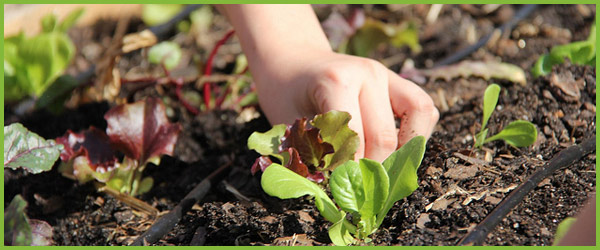17 Feb Gardening with the children this half term
Gardening With Kids
Gardening with children is great fun whatever their age. Children are enthralled by planting and caring for their growing flowers over the weeks – even children that normally wouldn’t concentrate for more than a matter of minutes on other “jobs”, really focus on their gardening.
Children love the excitement and anticipation of waiting for the seed to sprout and it’s the best way for them to learn how plants grow and what they need to survive; far better than reading about it in a book.
Gardening has loads of other things going for it too! It’s a healthy, outdoor activity which will keep them away from slumping in front of their computer games and it’s something that you can plan and enjoy doing together. All the parenting experts tell us that, to bond happily with your children, you need to find an activity that you as adults enjoy as much as the children.
Gardening could be the thing that you do together when you want to chat about important things … or unimportant things. Just having fun together.
You don’t have to have a massive garden or an allotment to enjoy gardening. In fact, if you’re just starting out, it’s often better to stick to window boxes and restricted areas. We’ve got lots of tips and ideas on how to grow flowers, herbs and veg in tiny spaces.
Gardening with children doesn’t cost the earth. In many cases you don’t have to buy anything special and we have some cost-saving tips for you too. And of course if you opt for growing fruit and veg you will find that you are saving money – we all know how much that organic fruit and veg can cost.
How To Make Gardening Fun ...
- There’s so much for children to learn – get them to tell you what is needed for plants to grow – encourage them to water their gardens regularly and observe the growth.
- Keep them involved, ask loads of questions: What do we need to do next? Where is the best spot for these? What do the instructions say? Will that seed grow in that bucket of water etc.. This way they feel they’re part of the job in hand.
- Explain that plants take time to grow and that they need sunlight and water. You can do a little experiment with older children to show this… grow 3 lots of cress: grow one lot in sunlight and water regularly, give another lot water but put in a dark cupboard and grow the final lot in the light, but don’t water. Get the children to look at each lot of cress each day and compare how they haven’t grown. (You can go on to tell them that most seeds also need soil to grow.)
- Take photos of the plants at different stages…. especially things like sunflowers. When you think about it, it’s amazing that a huge sunflower can grow from a small seed.
- When you get to the last few sheets of a kitchen roll, wet it and stand it inside a pint glass or tall jar, then drop a bean seed down the side. Keep the paper damp and you will see the bean sprout roots and then grow, a great way of showing what happens under the ground.
- Explain that the seeds are popped in the hole and then covered up to sleep, this helped make the younger children understand that the seeds are living and they need to be gentle with them.
- Gardening is a great way to develop physical skills like hand-eye coordination and fine motor skills. Children need to develop these skills, before they can hold and control a pen or pencil.
- Young children love plants which stimulate the senses (touch, sight, sound, taste and smell) … plants with soft leaves or bright flowers, grasses which rustle in the wind, aromatic herbs, scented flowers, fruit and vegetables. It can be particularly beneficial to grow sensory plants for children with special needs and sensory impairments, as it will encourage them to explore and enjoy their garden.
- Grow plants to attract wildlife e.g. wildflowers and buddleia will attract bees and butterflies. These insects will then pollinate your flowers, which will help you get good crop of fruit and vegetables.
- Get children involved in composting – have a small waterproof box next to the sink to throw kitchen waste in. Make a little a chart of what you can and can’t compost, so the children know what to put in and what has to go in the bin.
- Talk about the insects you find and how they are good or bad for your garden:
– hedgehogs and toads eat slugs that will eat your plants;
– worms are good as they make holes in the soil for air and water to get to your plants. Some bugs aren’t so good as they’ll eat your potatoes but, in true organic farming style, you can grow certain herbs close by to get rid of these mini-pests.
– ladybirds are great as they eat greenfly - Get your children to make plant labels to mark where seeds have been planted.
Start on a small scale – don’t be too ambitious and embark on a massive gardening project with your children. Better to keep it small and start with maybe potatoes in a bucket or sunflowers – these are quite enough for young children. Or even try cress egg heads with young children as it grows very fast and children can eat in salads and egg sandwiches after only a few days.
Wear old clothes – gardening has a high messy-ness factor that children love so maybe consider keeping some old clothes as gardening clothes.
Choose your plants carefully – don’t try plants that are inclined to shrivel and die if you turn your back for a moment. We’ve included a selection that are all fairly safe bets so it shouldn’t all end in tears.
Keep it fun and let them do as much as possible by themselves. Give them their own small section in the garden or their own pots, so they won’t ruin your grown up flower beds. Make sure “their garden” gets a decent amount of sun, otherwise nothing will grow and the children will be put off gardening. For younger children get them to name their plants for a bit of extra fun.
Step One is not necessarily your local garden centre – you don’t need to spend a fortune on tools or seed trays. To start with, margarine tubs and yogurt pots can be used to start your seeds off.
Use a lolly pop stick as a plant label and this can also be used to dib out your seedlings when they need planting out. Rather than buy trays with separate sections, use toilet roll tubes or egg cartons.
One thing that really is worth buying is a water spray gun so your children can help water the little plants as they grow rather than let them drown the poor things (and your workspace) with a watering can. You can get a spray bottle for kids in bright colours quite cheaply. This way even very young children can help with watering.
Another idea is to save the sports top bottles for kids to use when watering plants. It’s easier (and quicker) to make lots of trips back to the tap than let them loose with a lot of water in one go which will drown your seedlings.
... and finally
- Be relaxed about what the children are doing and be prepared for a mess, that way you won’t feel frustrated when they don’t plant little seeds in perfect straight lines.
- Make sure you’re planting outside as even the smallest job can turn into a huge mess if a toddler is involved.
- And don’t forget suncream and sun hats – even on days that aren’t brilliant sunshine they still need skin protection especially in the middle of the day.
“My kids love gardening but only for about 15 minutes then they turn their attention to looking at all the worms and bugs I dig up. It’s all good fun though”
“I got my daughter a little gardening kit for her birthday last year. She loves it – although still plants things and then digs it up so nothing grows!!!”
Source: Net Mums



